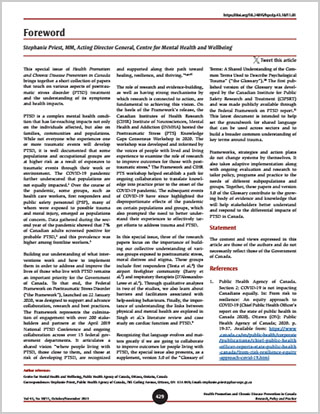Foreword

HPCDP Journal Home
Published by: The Public Health Agency of Canada
Date published: November 2023
ISSN: 2368-738X
Submit a manuscript
About HPCDP
Browse
Stephanie Priest, MM, Acting Director General, Centre for Mental Health and Wellbeing
https://doi.org/10.24095/hpcdp.43.10/11.01
Author reference
Centre for Mental Health and Wellbeing, Public Health Agency of Canada, Ottawa, Ontario, Canada
Correspondence
Stephanie Priest, Public Health Agency of Canada, 785 Carling Avenue, Ottawa, ON K1A 0K9; Email: stephanie.priest@phac-aspc.gc.ca
Suggested citation
Priest S. Foreword. Health Promot Chronic Dis Prev Can. 2023;43(10/11):429-30. https://doi.org/10.24095/hpcdp.43.10/11.01
This special issue of Health Promotion and Chronic Disease Prevention in Canada brings together a short collection of papers that touch on various aspects of posttraumatic stress disorder (PTSD) treatment and the understanding of its symptoms and health impacts.
PTSD is a complex mental health condition that has far-reaching impacts not only on the individuals affected, but also on families, communities and populations. While not everyone who experiences one or more traumatic events will develop PTSD, it is well documented that some populations and occupational groups are at higher risk as a result of exposures to traumatic events through their work or environment. The COVID-19 pandemic further underscored that populations are not equally impacted.Footnote 1 Over the course of the pandemic, some groups, such as health care workers, first responders and public safety personnel (PSP), many of whom were exposed to possible trauma and moral injury, emerged as populations of concern. Data gathered during the second year of the pandemic showed that 7% of Canadian adults screened positive for probable PTSD,Footnote 2 and this prevalence was higher among frontline workers.Footnote 3
Building our understanding of what interventions work and how to implement them in order to address and improve the lives of those who live with PTSD remains an important priority for the Government of Canada. To that end, the Federal Framework on Posttraumatic Stress Disorder (“the Framework”), launched on 22 January 2020, was designed to support and advance collaboration, research and best practices. The Framework represents the culmination of engagement with over 200 stakeholders and partners at the April 2019 National PTSD Conference and ongoing collaboration across over 15 federal government departments. It articulates a shared vision “where people living with PTSD, those close to them, and those at risk of developing PTSD, are recognized and supported along their path toward healing, resilience, and thriving.”Footnote 4,p.15
The role of research and evidence-building, as well as having strong mechanisms by which research is connected to action, are fundamental to achieving this vision. On the heels of the Framework’s release, the Canadian Institutes of Health Research (CIHR) Institute of Neurosciences, Mental Health and Addiction (INMHA) hosted the Posttraumatic Stress (PTS) Knowledge Gaps Consensus Workshop in 2020. The workshop was developed and informed by the voices of people with lived and living experience to examine the role of research to improve outcomes for those with posttraumatic stress.Footnote 5 The Framework and CIHR PTS workshop helped establish a path for ongoing collaboration to translate knowledge into practice prior to the onset of the COVID-19 pandemic. The subsequent events of COVID-19 have since highlighted the disproportionate effects of the pandemic on certain populations and groups, which also prompted the need to better understand their experiences to effectively target efforts to address trauma and PTSD.
In this special issue, three of the research papers focus on the importance of building our collective understanding of various groups exposed to posttraumatic stress, moral distress and stigma. These groups include first responders (Testa et al.Footnote 6) the airport firefighter community (Barry et al.Footnote 7) and respiratory therapists (D’Alessandro-Lowe et al.Footnote 8). Through qualitative analyses in two of the studies, we also learn about barriers and facilitators associated with help-seeking behaviours. Finally, the importance of understanding the links between physical and mental health are explored in Singh et al.’s literature review and case study on cardiac function and PTSD.Footnote 9
Recognizing that language evolves and matters greatly if we are going to collaborate to improve outcomes for people living with PTSD, the special issue also presents, as a supplement, version 3.0 of the “Glossary of Terms: A Shared Understanding of the Common Terms Used to Describe Psychological Trauma” (“the Glossary”).Footnote 10 The first published version of the Glossary was developed by the Canadian Institute for Public Safety Research and Treatment (CIPSRT) and was made publicly available through the Federal Framework on PTSD report.Footnote 11 This latest document is intended to help set the groundwork for shared language that can be used across sectors and to build a broader common understanding of key terms around trauma.
Frameworks, strategies and action plans do not change systems by themselves. It also takes adaptive implementation along with ongoing evaluation and research to tailor policy, programs and practice to the needs of different subpopulations and groups. Together, these papers and version 3.0 of the Glossary contribute to the growing body of evidence and knowledge that will help stakeholders better understand and respond to the differential impacts of PTSD in Canada.
Statement
The content and views expressed in this article are those of the authors and do not necessarily reflect those of the Government of Canada.
